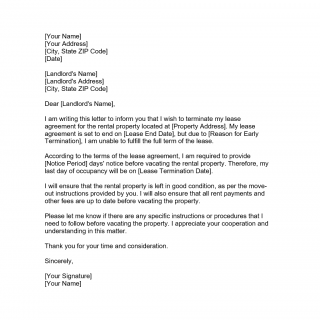Early Lease Termination Letter
An Early Lease Termination Letter is a formal document that tenants use to inform landlords of their intention to terminate their lease agreement before its specified end date. The main purpose of this letter is to provide notice to the landlord of the tenant's intent to vacate the rental property early.
The form typically consists of the following parts:
- Date of the letter
- Tenant's name and contact information
- Landlord's name and contact information
- Property address
- Date of lease termination
- Reason for early termination
- Signature of tenant
Important fields in the form include the date of the letter, the date of lease termination, and the reason for early termination. These fields are crucial in ensuring that the landlord receives proper notice of the tenant's intent to vacate early and that both parties are aware of the circumstances surrounding the termination.
Examples and practices of use for this form may include situations where the tenant has to move out of the rental property earlier than expected due to job relocation, family emergency, or other unforeseen circumstances. The form can also be used when both parties agree to terminate the lease early.
The parties involved in the form include the tenant and the landlord. The tenant is the person who is terminating the lease agreement early, while the landlord is the person who owns the rental property.
When compiling an Early Lease Termination Letter, it is important to consider the terms of the lease agreement, including any provisions related to early termination, fees, and penalties. It is also important to ensure that the letter is delivered to the landlord in a timely and proper manner, as specified in the lease agreement.
Sample of Early Lease Termination Letter
[Landlord's Name]
[Landlord's Address]
[City, State ZIP Code]Dear [Landlord's Name],
I am writing this letter to inform you that I wish to terminate my lease agreement for the rental property located at [Property Address]. My lease agreement is set to end on [Lease End Date], but due to [Reason for Early Termination], I am unable to fulfill the full term of the lease.
According to the terms of the lease agreement, I am required to provide [Notice Period] days' notice before vacating the rental property. Therefore, my last day of occupancy will be on [Lease Termination Date].
I will ensure that the rental property is left in good condition, as per the move-out instructions provided by you. I will also ensure that all rent payments and other fees are up to date before vacating the property.
Please let me know if there are any specific instructions or procedures that I need to follow before vacating the property. I appreciate your cooperation and understanding in this matter.
Thank you for your time and consideration.
Sincerely,
[Your Signature]
[Your Name]
Benefits of using an Early Lease Termination Letter include avoiding penalties and fees associated with breaking a lease agreement and maintaining a good relationship with the landlord. However, there may be risks involved, such as losing the security deposit or being held responsible for rent payments until a new tenant is found.
Related and alternative forms and analogues to the Early Lease Termination Letter may include a Notice to Vacate, which is used by tenants to inform landlords of their intention to vacate the rental property at a specific date, and a Mutual Termination Agreement, which is used by both parties to mutually agree to terminate a lease agreement before the end of its term.
The main difference between an Early Lease Termination Letter and other forms is that it specifically addresses the issue of terminating a lease agreement early, whereas other forms may address other issues related to the tenancy.
The form influences the future of the participants by providing a clear and formal notice of the tenant's intent to vacate early, which can help avoid conflicts and legal issues in the future.
The Early Lease Termination Letter is typically submitted to the landlord in writing, either by mail or email. It is important to keep a copy of the letter for personal records. The form is stored with the lease agreement and other relevant documents related to the tenancy.

